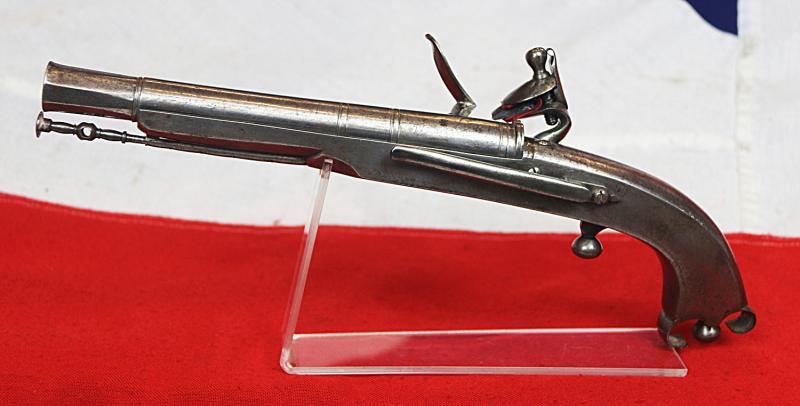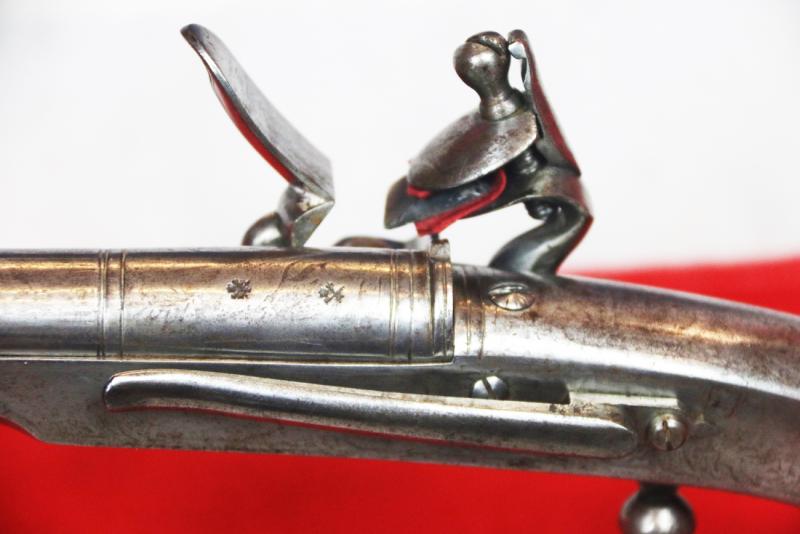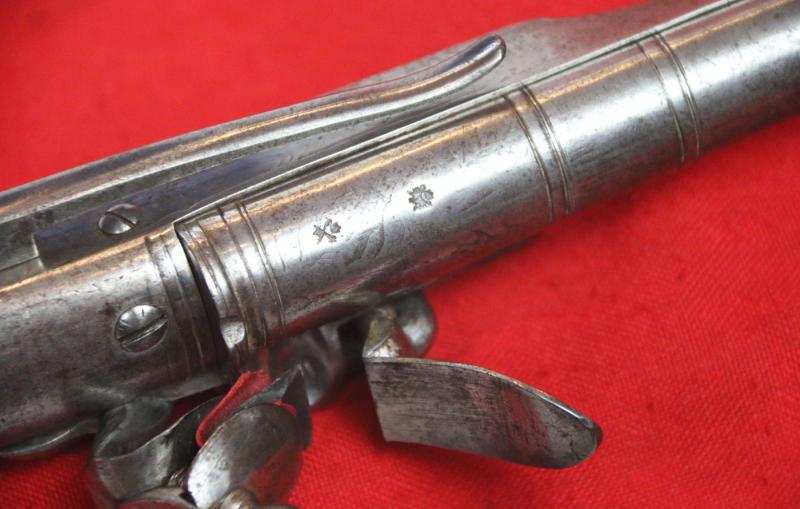A Rare & Beautiful, Early 19th Century, Scottish Rams Horn Butt, All Steel, Highlander's Flintlock Pistol Made by Macleod. In Super Condition, With All The Features As to Be Expected For a Fine, Original, Highland Officer's Regimental Pistol
A most fine and stunning, early 19th century, Scottish all steel highlander's flintlock belt pistol by MacLeod {a gunsmith works that was founded in the mid 18th century in Doune, Scotland} with flared octagonal muzzle and proved barrel, a signed lock of "highland" type and finely engraved with typical scrolls and a fern border, the entire stock finely and lightly etched overall with iconic thistles, scrolls and trophies. With fine highland ramshorn butt, with removable ball pricker between, and round ball trigger, side belt hook, and a fancy turned steel ramrod. A typical example of the "highland" type lock, but with a fine, automatic hook-cock, half-cock safety to stop accidental missfire. It ejects from the lock plate when cocking the hammer to safely and firmly hold it in place until full-cock is engaged. Beautifully tight and crisp action.
Highland regiment officer's and sergeants wore one steel pistol under the left arm, hung through the pistol's belt hook on a thin buff leather belt. See the original 18th century portrait painting of Captain Gorry of the Highland Volunteer Regiment, with his pistol belt-hook mounted under his left arm. {For illustrative purposes only}
Pistols were considered requisite items for the Highland soldier as early as the 1730s. By the 1740s the elegant pistol styles of Christie & Murdoch (armourers of Doune, Stirlingshire) had became the most sought after amongst Highland officers. The unique elements of the Doune pistols were the scroll or rams horn butt, fluted barrels at the breech and the octagonal flared muzzles. Soon pistol makers all across Scotland (and in England) began to copy the styles of Doune.
Another same form and age pistol by the same maker, signed MacLeod, with the highlanders scroll butt of an 18th century form, with flintlock and rainproof pan, stock, lock and barrel of decorated steel, silver butt escutcheons engraved with the crest of Scott of Abbotsford, sold for £18750 three years ago, in Edinburgh at auction.
A pair of pistols by the same maker which are still within the collection of Sir Walter Scott and on display at Abbotsford. The pistols on display are not only by the same maker but bear a similar armorial engraving as on the pistol sold in Edinburgh. More remarkably, the pistols are recorded in correspondence between Scott and the gunsmith, Mr.MacLeod, being commissioned by him for King George IV’s visit to Scotland in 1822.
Sir Walter Scott’s personal interest in Scottish history and life is well recorded and his collection of historical arms and armour is famous, much of which still decorates his remarkable Borders home, Abbotsford.
Sir Walter Scott, 1st Baronet FRSE FSAScot (15 August 1771 – 21 September 1832), was a Scottish novelist, poet and historian. Many of his works remain classics of European and Scottish literature, notably the novels Ivanhoe (1819), Rob Roy (1817), Waverley (1814), Old Mortality (1816), The Heart of Mid-Lothian (1818), and The Bride of Lammermoor (1819), along with the narrative poems Marmion (1808) and The Lady of the Lake (1810). He had a major impact on European and American literature.
Barrel length 7½", 13" overall length,
Code: 25228
6995.00 GBP










